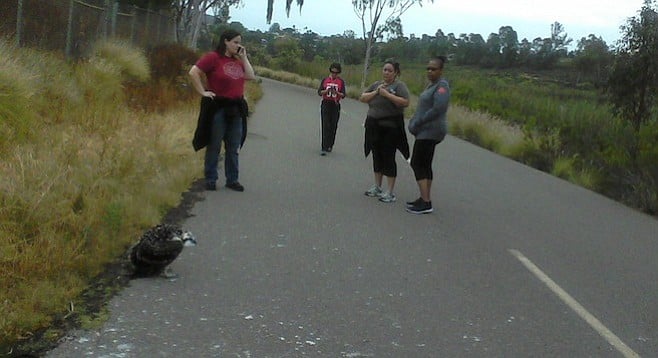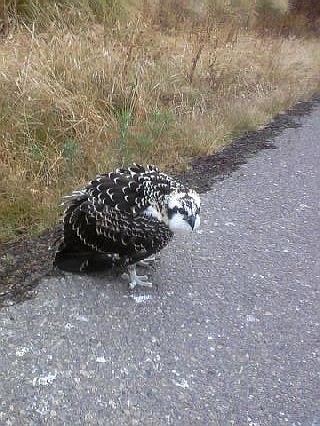 Facebook
Facebook
 X
X
 Instagram
Instagram
 TikTok
TikTok
 Youtube
Youtube

On May 9 at about 7 a.m., a baby osprey was spotted at the two-mile mark on the Lake Murray service road. It looked dazed but healthy as it sat there looking at the small crowd of people that had gathered to observe it.
In June 2013, two baby ospreys fell out of the same nest that is situated on top of a SDG&E transmission pole. On May 18 of 2014, another baby osprey fell there, too. SDG&E built the nest about 20 years ago because the natural osprey nests kept catching fire atop this pole. Hence, the birds have been living in that manmade nest ever since.

On May 9, a man said that he had witnessed the whole thing. The baby had tried its luck at flying, all the while losing altitude until the bird hit the ground. When it landed on the road, it did not try to fly; it just sat there.
A woman in the crowd said that she knew about birds, and she suggested that the bird was “posturing” when it slightly moved in reaction to the observing humans. Another woman called the park staff to come and help while the crowd stood around the osprey to prevent bikes from hitting the baby bird.
About 20 minutes later, Gayle Havens, the reservoir keeper, and a male volunteer arrived in the park service truck to take care of the situation. They quickly brought out a towel, net, and cage to pick up the osprey and take it to Project Wildlife.
Havens and the volunteer managed to coax the bird into the cage after covering its eyes with a towel and putting a net over the osprey. The volunteer said that the osprey was bigger than most babies but the grown-up osprey was much larger. The adult bird was said to have a seven-foot wingspan, quite a bit longer than the fallen bird that finally spread its wings when the park staff tried to catch it.
Havens did not think that the osprey was injured, but would be examined, fed, and put back in the nest.
One woman thought that the bird should be left alone on the road. She said to “let nature be nature.” However, most of the crowd and Lake visitors thought that Lake Murray was a city park with human traffic, rather than a natural forest. Someone pointed out that the bird came out of a manmade nest.
Oscar and his wife, two lake regulars who feed the birds daily, commented that “Lake Murray people take care of the animals.”


On May 9 at about 7 a.m., a baby osprey was spotted at the two-mile mark on the Lake Murray service road. It looked dazed but healthy as it sat there looking at the small crowd of people that had gathered to observe it.
In June 2013, two baby ospreys fell out of the same nest that is situated on top of a SDG&E transmission pole. On May 18 of 2014, another baby osprey fell there, too. SDG&E built the nest about 20 years ago because the natural osprey nests kept catching fire atop this pole. Hence, the birds have been living in that manmade nest ever since.

On May 9, a man said that he had witnessed the whole thing. The baby had tried its luck at flying, all the while losing altitude until the bird hit the ground. When it landed on the road, it did not try to fly; it just sat there.
A woman in the crowd said that she knew about birds, and she suggested that the bird was “posturing” when it slightly moved in reaction to the observing humans. Another woman called the park staff to come and help while the crowd stood around the osprey to prevent bikes from hitting the baby bird.
About 20 minutes later, Gayle Havens, the reservoir keeper, and a male volunteer arrived in the park service truck to take care of the situation. They quickly brought out a towel, net, and cage to pick up the osprey and take it to Project Wildlife.
Havens and the volunteer managed to coax the bird into the cage after covering its eyes with a towel and putting a net over the osprey. The volunteer said that the osprey was bigger than most babies but the grown-up osprey was much larger. The adult bird was said to have a seven-foot wingspan, quite a bit longer than the fallen bird that finally spread its wings when the park staff tried to catch it.
Havens did not think that the osprey was injured, but would be examined, fed, and put back in the nest.
One woman thought that the bird should be left alone on the road. She said to “let nature be nature.” However, most of the crowd and Lake visitors thought that Lake Murray was a city park with human traffic, rather than a natural forest. Someone pointed out that the bird came out of a manmade nest.
Oscar and his wife, two lake regulars who feed the birds daily, commented that “Lake Murray people take care of the animals.”
Comments